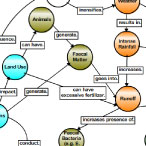|
|
Click Images to Enlarge
|
||||||||
Click Buttons for Presentation Videos & Maps |
About this Workshop:
For this workshop, 12 informal educators from the New England area (including the Seacoast Science Center and New England Aquarium) were matched with ocean and climate scientists from the University of New Hampshire to improve their collective understanding of Earth's climate and ocean systems. [more]
About this Scientist:
Ru Morrison has been involved in the Integrated Ocean Observing System (IOOS), which is a network of tools that collect and provide data for marine activities, and relies on outreach. He is the director of the Northeast Regional Association of Ocean Observing Systems (NERACOOS), a growing Ocean Observing network serving the Gulf of Maine and Northeast.
Ru's interests focus on using bio-optical techniques to study biogeochemical processes in the ocean. His research can be divided into two main categories that are not mutually exclusive: (1) the study of the temporal and spatial variability of optically important constituents and (2) phytoplankton photophysiology and ecology. To answer questions within these research categories I use both in-water optical measurements and ocean color remote sensing. [more]












